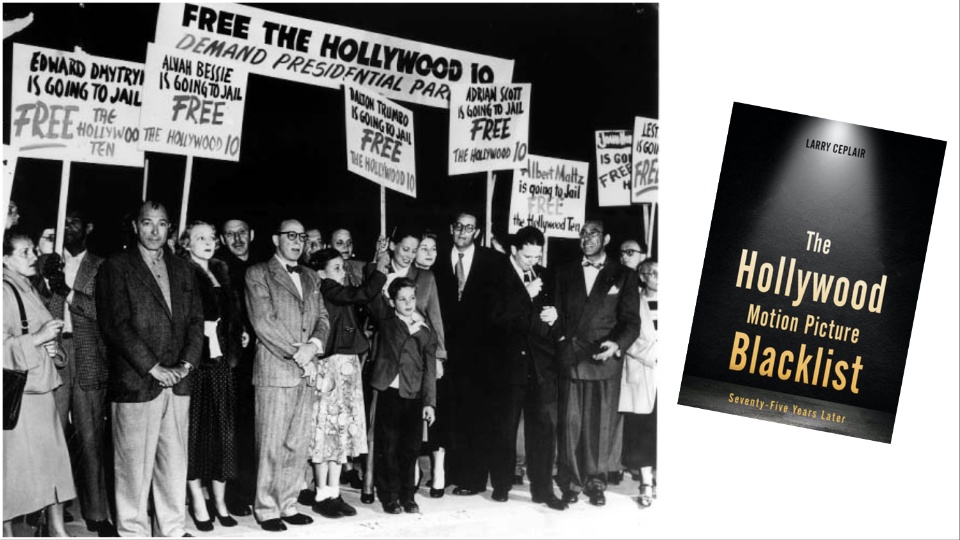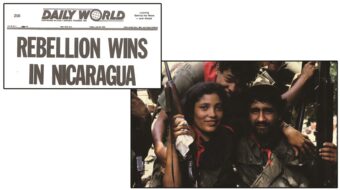
This fascinating book doesn’t advance just one argument, nor is it uniform in its methods or style. Instead, its eight chapters take fresh and varied approaches to problems old and new—issues of history, politics, culture, and conscience. What holds it all together is author Larry Ceplair’s supple wisdom, hard-earned over a long career, about the blacklist, the people it touched, and what it should mean now.
“The time seemed right for a book that offered some new thoughts,” Ceplair states in his preface, “a summing-up of what I have learned over the years.”
Throughout this volume, there’s never a doubt that Ceplair writes with honesty, fairness, empathy, and deep knowledge.
Chapter 1, “Looking Back,” explains the origins of the blacklist and offers a glance at “the pendulum swing of historiography,” the shifting attitudes toward a dark period in American culture:

- Of the 120 film industry employees who appeared before the House Un-American Activities Committee (HUAC) from 1947 to 1953, 76 refused to cooperate (invoking either the First or Fifth Amendment) and 39 cooperated by naming names.
- Throughout the 1950s, the turbocharged atmosphere of Cold War anti-Communism welcomed continued proscription and censorship. In popular culture, the Hollywood Ten and all unfriendly HUAC witnesses were viewed with hostility.
- In the 1970s the blacklistees were finally allowed to speak for themselves in books and documentaries, and by 1980 the tide had turned. The victims of the witch hunt became generally admired and respected.
- To this day, however, a cadre of conservative historians continues to reject any book or author that is sympathetic to the Hollywood Ten or that “does not excoriate the blacklisted people for their refusal to ‘apologize’ for their political past.”
- On the 75th anniversary of the blacklist, we still stand on “the same contested ground of interpretation.” Anti-Communist pundits accuse the unfriendly witnesses of criminal deceit, and leftists accuse the friendly witnesses of gross acts of betrayal.
Chapter 3, “A Debate over the Politics and Morality of Cooperative and Uncooperative Witnesses,” sorts out the dilemma by asking key questions: What happens when the state pressures its citizens to betray other citizens? What are the consequences of betrayal and collaboration? Ceplair’s debate relies on two diametrically opposed book-length arguments as benchmarks for comparison: Victor Navasky’s 1980 study Naming Names and Alan Casty’s 2009 book, Communism in Hollywood.
- Navasky, sympathetic to the Left, argues that being a Communist was not a crime. HUAC’s pressure to name names was not a quest for evidence but a stigmatizing “degradation ceremony.” The namers “violated their values and betrayed their fellow humans.”
- Casty, a conservative, detests unrepentant Communists and “romanticized” views of the Hollywood Ten. He argues that unfriendly witnesses, by their silence, protected a criminal regime and were complicit in Stalinism. Informers simply told the “truth.”
- Navasky holds that it is immoral to inform on one’s friends and former comrades. He concludes that the informers “accepted their role as key instruments in the show-trial purgation staged by the House Committee.”
- Casty asserts that it is immoral to defend the Soviet Union and moral to “to expose the identities of those who were Communists.” He gives the unfriendly witnesses no credit for having principled beliefs about freedom of speech or political expression.
After analyzing these competing arguments, Ceplair adds two observations of his own, which turn out to be crucial:
- First, “Though both sets of witnesses wished to avoid being blacklisted, the unfriendly witnesses chose to sacrifice only themselves; the friendly witnesses chose to sacrifice others.”
- Second, the vast majority of the unfriendly witnesses with whom Ceplair has talked, or about whom he has read, “are certain that they did the right thing, and they would do so again.” In contrast, many of those who named names feel regret; Ceplair describes them as “ambivalent and rueful.”
Of course, a version of this politically charged divide is still in effect. Making my way through Ceplair’s book, I wished I’d read it earlier because it would have explained some baffling responses to my own recent book.
Michael Gold: The People’s Writer is a biography of a once-famous Jewish-American radical writer, active from 1914 until his death in 1967. Though the book and its arguments were well-received, it also elicited outrage.
In Commentary, conservative political scientist Harvey Klehr reviled Mike Gold while attacking the very idea of a sympathetic biography of a Communist artist: “That such a wasted life can be seen as a wonderful heritage today bespeaks a failure of common sense and moral integrity on the part of Patrick Chura and all who might be inclined to think well of this shameful book.” Klehr’s review, cleverly titled “Tarnished Gold,” scored points with the far right; it was liked and retweeted by more than one Fox News commentator.
Edward S. Shapiro published an almost identical article in the journal of the National Association of Scholars, a conservative advocacy organization. Prof. Shapiro, a Harvard-trained historian born in 1938, wondered why Gold was never convinced of “the superiority of capitalism.” He touted American Exceptionalism and objected to my book’s title: “What people?” he wondered. “The people who actually read and admired Mike Gold never comprised more than a small sect of isolated, disgruntled, and estranged individuals.” Klehr and Shapiro remind us, as Ceplair’s book does, that reactionary Cold War fears and orthodoxies linger.
Also helpful in understanding the antagonism toward leftists like Mike Gold and the Hollywood Ten is Ceplair’s chapter 2, “Jewish Anti-Communism in the United States and Hollywood.” Here, Ceplair makes good on his promise to break new ground. He examines Jewish anti-Communism in the Cold War-era film industry as “a distinct subcategory,” shedding light on the thought processes of movie executives who enforced the blacklist. His findings:
- Faced with alarming anti-Semitism, some 20th-century Jewish communities embraced an agenda focused on dissolving public perceptions linking Jewishness and Communism.
- Two Jewish studio heads, Jack Warner and Louis B. Mayer, avowed strong opposition to Communism and became, in effect, the first HUAC informers. According to Jewish screenwriter Michael Blankfort, “They were…terribly frightened Jews who rejected their background to become super-Americans.”
- The Rosenberg case brought many American Jews who were previously non-committal on Communism “into the anti-Communist camp.” Religious leaders decided that an important task was to protect Jews from accusations of being unpatriotic and soft on Communism.
- Though Jewish anti-Communism was “a minor element in the Cold War,” it contributed to an oppressive atmosphere and “damaged the main ideals of Judaism: justice and fair treatment.”
Ceplair’s book also includes three biographical chapters presenting case histories of the political development of HUAC targets, including Ring Lardner, Jr., Dashiell Hammett, and Isobel Lennart. Particularly entertaining and crisply written is the chapter on Lardner. Ceplair tells of a 1978 interview in which Lardner was asked why the world needed to remember the “ancient history” of the Hollywood Ten. “Because our nation has moved through two centuries in a continuous cycle from liberty to repression and back,” he replied.

In the eighth chapter, Ceplair signs off with a mini-manifesto. Here’s what it boils down to:
The history of the United States is replete with banishments of typed people from full citizenship, civil rights, and civil liberties. Although progress has been made on many fronts, the United States remains a racist, misogynist, nativist, and anti-Left country, dominated by huge media entities. And, as the Trump presidency has demonstrated, it does not take much for the pendulum of history to swing back to an intolerant, suppressive, and frankly scary phase.
Finally, it’s interesting that Ceplair dedicates his book “To the Memory of Albert Maltz.” Though Maltz is only briefly discussed in the text, this dedication makes sense, and not simply because, in Ceplair’s words, “Albert was a generous and caring man.” Maltz famously termed himself a “citizen writer.” As a Hollywood Ten witness before committee chair J. Parnell Thomas, he declared, “The American people are going to have to choose between the Bill of Rights and the Thomas committee. They cannot have both.”
Anyone familiar with Maltz’s career before the Cold War could have predicted this response, which doomed Maltz to the status of pariah and non-person for twenty years.
Moreover, Maltz’s brief post-blacklist career gave the lie to the charge that the unfriendly HUAC witnesses were morally unprincipled and “shameful.” When he learned of authoritarian abuses going on in the Soviet Union—incarceration of dissidents in psychiatric institutions, crackdowns on peaceful protests after the invasion of Czechoslovakia in 1968, and the expulsion of Alexander Solzhenitsyn from the Soviet Writers Union in 1969—Maltz publicly offered to donate his uncollected Soviet royalties (about 34,000 rubles) to Solzhenitsyn to relieve the banned writer’s financial hardships. As a result, Maltz’s contracts with Moscow publishers were permanently canceled. Yes, Albert Maltz was blacklisted in both the United States and the Soviet Union.
In any treatment of the morality play that was the blacklisting era, Maltz deserves to figure prominently, as Ceplair acknowledges in his thoughtful dedication: “[His] fidelity to the historical record, while a pain in the ass to some, was an inspiration to me.”
Larry Ceplair
The Hollywood Motion Picture Blacklist Seventy-Five Years Later
University Press of Kentucky, 2022, 234 pp.
ISBN 9780813195889
We hope you appreciated this article. At People’s World, we believe news and information should be free and accessible to all, but we need your help. Our journalism is free of corporate influence and paywalls because we are totally reader-supported. Only you, our readers and supporters, make this possible. If you enjoy reading People’s World and the stories we bring you, please support our work by donating or becoming a monthly sustainer today. Thank you!












Comments